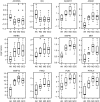Key differences identified between actinic keratosis and cutaneous squamous cell carcinoma by transcriptome profiling
- PMID: 24335922
- PMCID: PMC3899778
- DOI: 10.1038/bjc.2013.760
Key differences identified between actinic keratosis and cutaneous squamous cell carcinoma by transcriptome profiling
Abstract
Background: Cutaneous squamous cell carcinoma (cSCC) is one of the most common malignancies in fair-skinned populations worldwide and its incidence is increasing. Despite previous observations of multiple genetic abnormalities in cSCC, the oncogenic process remains elusive. The purpose of this study was to elucidate key molecular events associated with progression from premalignant actinic keratoses (AKs) to invasive cSCC by transcriptome profiling.
Methods: We combined laser capture microdissection with the Affymetrix HGU133 Plus 2.0 microarrays to profile 30 cSCC and 10 AKs.
Results: We identified a core set of 196 genes that are differentially expressed between AK and cSCC, and are enriched for processes including epidermal differentiation, cell migration, cell-cycle regulation and metabolism. Gene set enrichment analysis highlighted a key role for the mitogen activated protein kinase (MAPK) pathway in cSCC compared with AK. Furthermore, the histological subtype of the tumour was shown to influence the expression profile.
Conclusion: These data indicate that the MAPK pathway may be pivotal to the transition from AK to cSCC, thus representing a potential target for cSCC prevention. In addition, transcriptome differences identified between cSCC subtypes have important implications for future development of targeted therapies for this malignancy.
Figures



Similar articles
-
Gene expression landscape of cutaneous squamous cell carcinoma progression.Br J Dermatol. 2024 Oct 17;191(5):760-774. doi: 10.1093/bjd/ljae249. Br J Dermatol. 2024. PMID: 38867481
-
Pathogenic genes related to the progression of actinic keratoses to cutaneous squamous cell carcinoma.Int J Dermatol. 2018 Oct;57(10):1208-1217. doi: 10.1111/ijd.14131. Epub 2018 Aug 13. Int J Dermatol. 2018. PMID: 30105812
-
The Genomic Landscape of Actinic Keratosis.J Invest Dermatol. 2021 Jul;141(7):1664-1674.e7. doi: 10.1016/j.jid.2020.12.024. Epub 2021 Jan 19. J Invest Dermatol. 2021. PMID: 33482222 Free PMC article.
-
Telomeres and Telomerase in Cutaneous Squamous Cell Carcinoma.Int J Mol Sci. 2019 Mar 16;20(6):1333. doi: 10.3390/ijms20061333. Int J Mol Sci. 2019. PMID: 30884806 Free PMC article. Review.
-
Dermatopathologic features of cutaneous squamous cell carcinoma and actinic keratosis: Consensus criteria and proposed reporting guidelines.J Am Acad Dermatol. 2023 Jun;88(6):1317-1325. doi: 10.1016/j.jaad.2022.12.057. Epub 2023 Feb 24. J Am Acad Dermatol. 2023. PMID: 36841336 Review.
Cited by
-
Genetic Studies of Actinic Keratosis Development: Where Are We Now?Ann Dermatol. 2023 Dec;35(6):389-399. doi: 10.5021/ad.23.072. Ann Dermatol. 2023. PMID: 38086352 Free PMC article. Review.
-
circ_0001821 Contributes to the Development of Cutaneous Squamous Cell Carcinoma by Regulating MicroRNA-148a-3p/EGFR Axis and Activating Phosphatidylinositol 3-Kinase/Akt Pathway.Mol Cell Biol. 2022 Mar 17;42(3):e0008921. doi: 10.1128/MCB.00089-21. Epub 2022 Feb 22. Mol Cell Biol. 2022. PMID: 35191745 Free PMC article.
-
Transcriptomic Study on Human Skin Samples: Identification of Two Subclasses of Actinic Keratoses.Int J Mol Sci. 2023 Mar 21;24(6):5937. doi: 10.3390/ijms24065937. Int J Mol Sci. 2023. PMID: 36983009 Free PMC article.
-
Protein Tyrosine Kinase 6 Regulates UVB-Induced Signaling and Tumorigenesis in Mouse Skin.J Invest Dermatol. 2015 Oct;135(10):2492-2501. doi: 10.1038/jid.2015.166. Epub 2015 Apr 30. J Invest Dermatol. 2015. PMID: 25938342 Free PMC article.
-
Characterizing Dermal Transcriptional Change in the Progression from Sun-Protected Skin to Actinic Keratosis.J Invest Dermatol. 2023 Jul;143(7):1299-1302.e3. doi: 10.1016/j.jid.2022.12.021. Epub 2023 Jan 26. J Invest Dermatol. 2023. PMID: 36708948 Free PMC article. No abstract available.
References
-
- Arnault JP, Mateus C, Escudier B, Tomasic G, Wechsler J, Hollville E, Soria JC, Malka D, Sarasin A, Larcher M, Andre J, Kamsu-Kom N, Boussemart L, Lacroix L, Spatz A, Eggermont AM, Druillennec S, Vagner S, Eychene A, Dumaz N, Robert C. Skin tumors induced by sorafenib; paradoxic RAS-RAF pathway activation and oncogenic mutations of HRAS, TP53, and TGFBR1. Clin Cancer Res. 2012;18 (1:263–272. - PubMed
-
- Ashton KJ, Weinstein SR, Maguire DJ, Griffiths LR. Chromosomal aberrations in squamous cell carcinoma and solar keratoses revealed by comparative genomic hybridization. Arch Dermatol. 2003;139 (7:876–882. - PubMed
-
- Breuninger H, Brantsch K, Eigentler T, Hafner HM. Comparison and evaluation of the current staging of cutaneous carcinomas. J Dtsch Dermatol Ges. 2012;10 (8:579–586. - PubMed
-
- Brown VL, Harwood CA, Crook T, Cronin JG, Kelsell DP, Proby CM. p16INK4a and p14ARF tumor suppressor genes are commonly inactivated in cutaneous squamous cell carcinoma. J Invest Dermatol. 2004;122 (5:1284–1292. - PubMed
-
- Clausen OP, Aass HC, Beigi M, Purdie KJ, Proby CM, Brown VL, Mattingsdal M, Micci F, Kolvraa S, Bolund L, Deangelis PM. Are keratoacanthomas variants of squamous cell carcinomas? A comparison of chromosomal aberrations by comparative genomic hybridization. J Invest Dermatol. 2006;126 (10:2308–2315. - PMC - PubMed
Publication types
MeSH terms
Substances
Grants and funding
LinkOut - more resources
Full Text Sources
Other Literature Sources
Medical
Molecular Biology Databases

